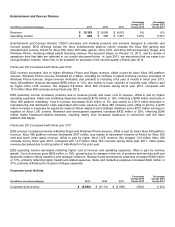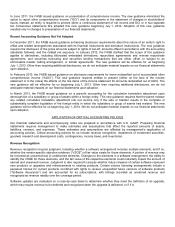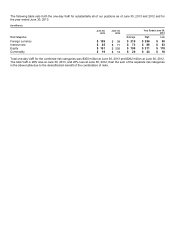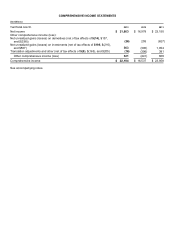Microsoft 2013 Annual Report Download - page 35
Download and view the complete annual report
Please find page 35 of the 2013 Microsoft annual report below. You can navigate through the pages in the report by either clicking on the pages listed below, or by using the keyword search tool below to find specific information within the annual report.
(a) See Note 12 – Debt of the Notes to Financial Statements.
(b) These amounts represent commitments for the construction of buildings, building improvements, and leasehold
improvements.
(c) These amounts represent undiscounted future minimum rental commitments under noncancellable facilities leases.
(d) These amounts represent purchase commitments, including all open purchase orders and all contracts that are take-
or-pay contracts that are not presented as construction commitments above.
(e) We have excluded long-term tax contingencies, other tax liabilities, and deferred income taxes of $11.3 billion and
other long-term contingent liabilities of $162 million (related to the antitrust and unfair competition class action
lawsuits) from the amounts presented, as the amounts that will be settled in cash are not known and the timing of
any payments is uncertain. We have also excluded unearned revenue and non-cash items.
Other Planned Uses of Capital
We will continue to invest in sales, marketing, product support infrastructure, and existing and advanced areas of
technology. Additions to property and equipment will continue, including new facilities, data centers, and computer
systems for research and development, sales and marketing, support, and administrative staff. We expect capital
expenditures to increase in coming years in support of our cloud and devices strategy. We have operating leases for most
U.S. and international sales and support offices and certain equipment. We have not engaged in any related party
transactions or arrangements with unconsolidated entities or other persons that are reasonably likely to materially affect
liquidity or the availability of capital resources.
Liquidity
We earn a significant amount of our operating income outside the U.S., which is deemed to be permanently reinvested in
foreign jurisdictions. As a result, as discussed above under Cash, Cash Equivalents, and Investments, the majority of our
cash, cash equivalents, and short-term investments are held by foreign subsidiaries. We currently do not intend nor
foresee a need to repatriate these funds. We expect existing domestic cash, cash equivalents, short-term investments,
and cash flows from operations to continue to be sufficient to fund our domestic operating activities and cash
commitments for investing and financing activities, such as regular quarterly dividends, debt repayment schedules, and
material capital expenditures, for at least the next 12 months and thereafter for the foreseeable future. In addition, we
expect existing foreign cash, cash equivalents, short-term investments, and cash flows from operations to continue to be
sufficient to fund our foreign operating activities and cash commitments for investing activities, such as material capital
expenditures, for at least the next 12 months and thereafter for the foreseeable future.
Should we require more capital in the U.S. than is generated by our operations domestically, for example to fund
significant discretionary activities, such as business acquisitions and share repurchases, we could elect to repatriate
future earnings from foreign jurisdictions or raise capital in the U.S. through debt or equity issuances. These alternatives
could result in higher effective tax rates, increased interest expense, or dilution of our earnings. We have borrowed funds
domestically and continue to believe we have the ability to do so at reasonable interest rates.
RECENT ACCOUNTING GUIDANCE
Recently Adopted Accounting Guidance
In September 2011, the Financial Accounting Standards Board (“FASB”) issued guidance on testing goodwill for
impairment. The new guidance provides an entity the option to first perform a qualitative assessment to determine
whether it is more likely than not that the fair value of a reporting unit is less than its carrying amount. If an entity
determines that this is the case, it is required to perform the two-step goodwill impairment test to identify potential goodwill
impairment and measure the amount of goodwill impairment loss to be recognized for that reporting unit (if any). If an
entity determines that the fair value of a reporting unit is greater than its carrying amount, the two-step goodwill
impairment test is not required. We adopted this new guidance beginning July 1, 2012. Adoption of this new guidance did
not have a material impact on our financial statements.
























